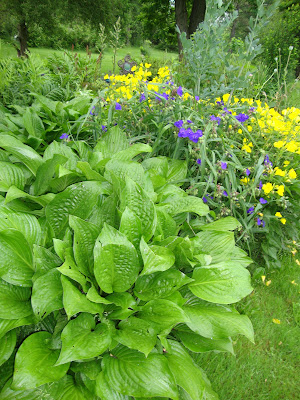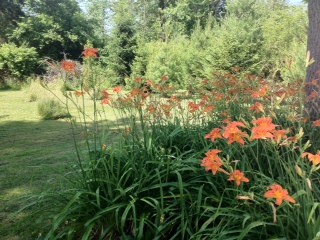Are you a garden lover? If so, perhaps this is one of the reasons you’ve decided to stay fit and strong. One of my “whys” for getting strong is to be able to garden for hours without pain or being uncomfortable, but can I really count gardening as exercise?
UPDATE: Parade Magazine posted this on Nov 6, a week after I wrote this article: If You Want To Live to 100, Aging Experts Say You Should Take Up This Hobby ASAP. Please note, I don’t consider Parade Magazine to be the best source of health and fitness news, but it was interesting to me that it was gardening. The writer, Emily Laurence, is a journalist and health coach.
Trimming back overgrown tree branches, moving large clumps of hosta plants, and taking out “volunteer” saplings — while none of these activities are especially tiring, if I’m not fit, it becomes pretty obvious by the next morning with sore muscles and an aching back.
I have five good size flower gardens of perennials and a separate 100 foot section about four feet wide bordering the road. It’s filled with various flowering bushes and perennials that require regular trimming and weeding. In fact, most of my gardening during these days of autumn involve weeding and trimming.
In the early spring, there are yellow flowers (daffodils and jonquils) and bushes (mostly forsythia) with lots of purple (iris, lilacs, rhododendrons, spider wart, coming on strong in late May. At that point the fear of frost is gone and I bring out so many of my potted plants (hibiscus, coleus, succulents and geraniums) and replant some of the tuber bulbs (Canna lilies.)
In early May, wisteria has beautiful draping flowers (pictured.) While the blooms are beautiful, it’s an ongoing battle to keep the plant in check and when I’m working on it, KI feel like it grows like the creeping vine in the moving Jumanji. It’s amazing how invasive this beautiful wisteria plant can grow and how difficult it is to control, but it’s a beauty!
In recent years, when there has been more bike riding, I find it difficult to spend enough time gardening and weeds.
My gardening routine goals for early spring is to get 15 minutes of weeding each morning. In April when we get a lot of rain, I have to be careful of the mud so I don’t get too hard of a soil mixture. In May I usually extend it to an hour. If the weather cooperates and I’m able to get out and do it, I’m really happy in June.
My garden mantra is “15 minutes in April is worth an hour and a half in June.” In truth, anything done in April (if it’s not too muddy) and in May (the earlier the better) really makes the summer gardens beautiful.
June brings peonies and lemon drops. The weeds will have really taken over any garden bed that I didn’t previously weed and cut back.

Usually we get a couple of bad wind storms by now and I’ve done my share of dragging tree branches, lifting logs into my garden cart or wheelbarrow and rolling huge hunks of stumps out of the way. The past three summers we’ve had multiple wind storms that required serious chain sawing and ground crew work. I do count this part of gardening as exercise. It burns a ton of calories, my heart rate is in cardio for more than an hour and I’ve easily gotten more than 10,000 steps from this type of workout.
Meanwhile July 1st, my day lilies have started blooming – mostly the orange ones I call ditch lilies because they are so easy to grow.

The orange day lilies will bloom only for one day and then they are gone, but the stalks have many buds and the orange ones will continue to bloom until the darker double lilies and magenta lilies take over in August.
In the fall, I make it my mission to trim and really cut all the bushes. It’s the opposite of April but getting everything ready for winter makes the coming spring much easier to maintain. I like to keep them no taller than me (so it’s easy to manage each year.) The exception to this are lilacs and the large rhododendron at the corner of the house. I let them get big and tall.
Several hours in the garden, especially on the weekends, really sets it up for a great spring. Hydrangeas are still a bit of a mystery to me, because sometimes they grow on the wood part of the vine, others like the new growth for flowering. I’m still not sure which kind I have.
Some of my front gardens have a lot of English Ivy and Creeping Jenny. It makes a nice ground covering but can get out of control as well.

A little bit of either of these is a lot as both of these vines like to take over. These two vines like to cover and squeeze out the holly bushes, clematis and azaleas – actually any of my flowering bushes and plants. Sometimes the English Ivy starts climbing up the house or hiding poison ivy. And the Creeping Jenny tends to put down roots in nearby soil which has a tendency to trip me when I’m walking thru a dense group of it. (Fall hazards are always bad!)
Actually, I don’t know the names of many of my bushes and plants, but since we’ve lived here for more than 30+ years, I am pretty familiar with all of them. Each year I swear I’m going to cut back and do less next year. However, even with cutting the foliage back, I find myself saving seeds, splitting perennials and rooting clippings during the winter.
Believe me there is a lot of bending, stretching, lifting and carrying when it comes to gardening. Honestly I don’t count gardening as exercise. It’s not really cardio, not really resistance training and definitely not a yoga class.
I’ll tell you what, after a couple of hours in the garden, I’m so thankful for doing cardio, resistance training and yoga to keep me flexible and strong!
Do you like to garden? Do you find that working out and exercising regularly supports your hobby? Let me know in the comments below.

Your garden journey is lovely. Personally I don’t consider gardening exercise as it does not maintain the level of intensity for a prolonged time. With that said, if we do strength and cardiovascular exercises all year it makes it much easier to do our hobbies such as gardening. Jane